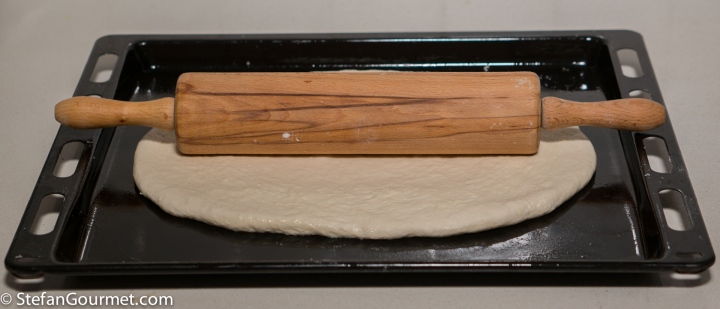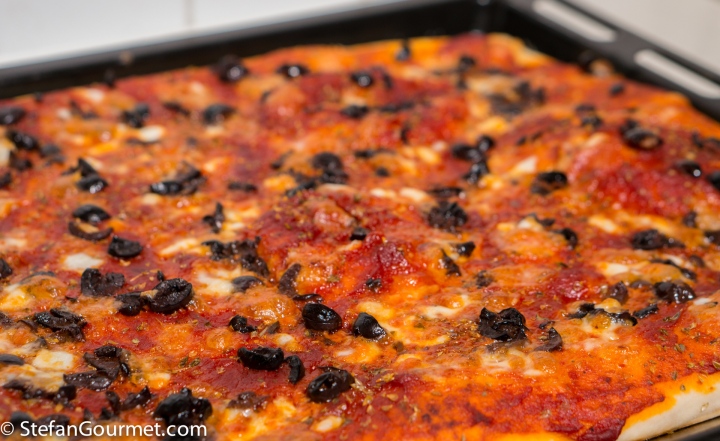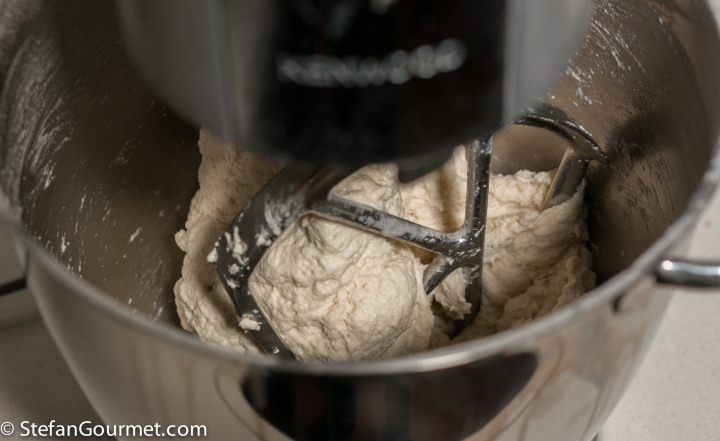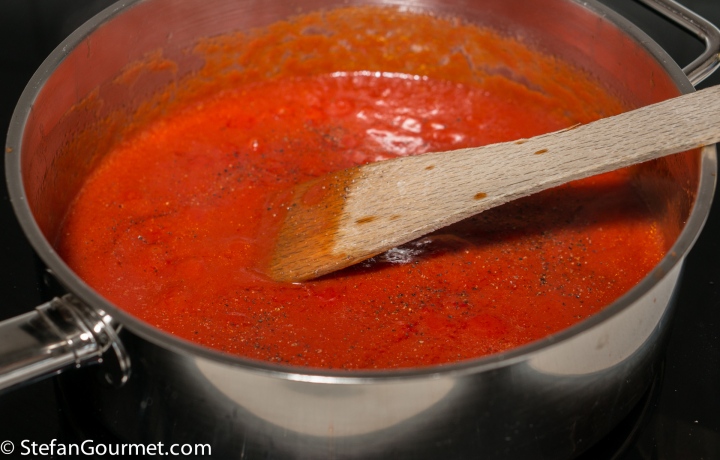In Italy there are two kinds of pizza. Round and thin pizza, cooked for a couple of minutes in a very hot (wood-fired) oven, is available in pizzerias. That type of pizza is difficult to make at home with a domestic oven (but it is not impossible to get close, click here to find out how). Rectangular and thick pizza is available at bakeries and called pizza in teglia (teglia means baking sheet). It is sometimes already cut into portions, or it is sold by weight. This is like bread with a pizza topping, and easy to make at home. Most recipes for homemade pizza are therefore actually pizza in teglia, even if they are made in a round pizza pan.
You can make this pizza in any shape of pan that you like. By calculating the surface area of the pan, you can calculate how much dough you will need. My rectangular sheet pan is 37 by 31 centimers (measured on the inside), so a surface area of 37 * 31 = 1147 square centimeters. Divide this by 3, and you know how many grams of flour you will need for the dough. 1147 / 3 = 382, so that’s about 400 grams of flour. (If using a round pizza pan, measure the diameter, divide it by 2, calculate the square, and then multiply by 3.14. For 30 centimers, 15 * 15 * 3.14 = 706 square centimers, and 706 / 3 = 235 grams of flour.) Do you measure pans in inches and flour in cups? No problem: calculate the surface area of your pan in square inches and divide by 70 to get the number of cups of flour you will need. So a for a 12 inch round pizza, 6 * 6 * 3.14 / 70 = 1.6 cups.
After this math lesson (perhaps pizza is a fun way to teach your children some math?) it is time to bake pizza! Use any topping you like. In this case, I used black olives and buffalo mozzarella. For a classic thin pizza it is best to use uncooked sieved tomatoes (passata), but for a thick pizza like this it is better to cook a tomato sauce to get the right balance of flavors. You could also use cold fermented pizza dough for this, which is easier to stretch and has a better flavor (but requires you to plan days ahead to have pizza). But sheet pan pizza is more forgiving than the classic round and thin version (which shouldn’t be stretched with a rolling pin to get the proper edge, and is difficult to bake ‘just right’ with crispy outside and soft inside), so regular dough is just fine.
Ingredients
For a pizza of about 1200 square centimeters (30 x 40 cm), or 192 square inches (12 x 16 inch)
For the dough (using the percentages you can scale this to any size baking sheet or pizza pan)
400 grams (2 2/3 cups) pizza flour (or bread flour) [100%]
240 grams (1 cup) water at room temperature [60%]
8 grams salt (about 1 tsp) [2%]
32 grams (2 Tbsp) extra virgin olive oil [8%]
16 grams fresh yeast [4%] (5.3 grams [1.3%] instant yeast or active dry yeast, about 2 tsp)
For the tomato sauce
250 ml (1 cup) passata (sieved tomatoes, tomato puree)
1 clove garlic
salt and freshly ground black pepper
2 Tbsp extra virgin olive oil
For the topping
dry oregano
125 grams (4.4 oz) buffalo mozzarella
chopped black olives, or whatever topping you like
Instructions
Measure the water.
If using fresh yeast, crumble it into the water and stir to mix.
If using active dry yeast, add it to the water and stir to mix.
If using instant yeast, add it to the flour.
Put the flour with the salt in the bowl of the stand mixer.
Mix with the paddle attachment until the salt has been mixed into the flour. Then add the water slowly while the machine is running. Add the olive oil as well.
Continue to mix untilt he dough has come together and there is no more dry flour visible.
Switch over to the dough hook.
Knead on low speed until the dough is smooth and elastic, about 10 minutes.
Remove the dough hook.

Cover the dough with plastic wrap, and allow to rise until doubled in volume, about 60 to 90 minutes.

The dough should be doubled in volume.

Turn the dough out onto a work surface (preferably wood) that you had sprinkled with flour, and quickly knead it into a round shape with your hands.

Grease the baking sheet or pizza pan with olive oil, using kitchen paper.

Transfer the dough to the greased baking sheet or pizza pan, and roll it out with a rolling pin. You can also use your hands to stretch it.

A small roller with a handle is handy to roll out the dough all the way into the corners of the baking sheet.

The dough may be a bit recalcitrant because it is so elastic, but in the end you should succeed to make it cover most of the baking sheet.

Cover with plastic wrap and allow to rise for about an hour.
In the meantime, make the tomato sauce. Heat 2 tablespoons of olive oil in a frying pan and add a sliced clove of garlic. Cook the garlic over low heat until slightly golden, then discard the garlic. This will flavor the oil.
Now add the passata.
Season with salt and freshly ground black pepper, and bring to a boil. When it boils, reduce the heat to low.
Simmer the tomato sauce over low heat, stirring regularly, until it is no longer watery. You can check this with a wooden spatula: the sauce should no longer ‘leak’ water. Turn off the heat.
If the pizza dough has risen, preheat the oven at 220C/430F (fan forced) or 240F/460F (not fan forced).
Spread out the tomato sauce on top of the pizza.
Sprinkle generously with dried oregano.
Top with whatever topping you like.
Bake the pizza in the preheated oven until the bottom is golden brown and the cheese has melted and is bubbly, about 15 minutes.
Flashback
Salsify sprinkled with fermented black beans and duck breast, both cooked sous-vide.





















Your tomato sauce is so deep colored – beautiful! I see you use a stand mixer. I haven’t made that jump yet but it’s happening soon!
LikeLiked by 1 person
I had put off getting a stand mixer for a long time because I thought it was too expensive, but I’ve never regretted getting one (I think it was about 4 years ago now). It is now so much easier to make dough (bread dough, pizza dough, etc.).
LikeLike
I have an upcoming post on finally breaking down and buying one. Just by coincidence I happened upon a post-Christmas (I’m assuming) sale, so the cost wasn’t an excuse anymore! Excited to use it!
LikeLiked by 1 person
Being a huge pizza fan, this would be a sure hit with me.
LikeLiked by 1 person
You bring me back to my youth with this pizza, Stefan. My grandmother used to make pizza very much like this when I was a boy. It was one of my favorite treats!
LikeLiked by 1 person
If I remember correctly, you prefer cold fermented dough for the classic pizza. Do you think, this would make a difference here?
LikeLike
Well remembered! It would make a difference here in flavor as well as how easy it is to stretch the dough. For classic pizza it is more important, because you want to be able to stretch that with your hands to get the proper edges. Thanks for reminding me, I’ve now added a comment to the post.
LikeLike
I like pizza in any shape or form, even bog standard supermarket pizza.
I tend to use a cold fermentation also for pizza al taglio (following Bonci’s recipe – he is a very famous pizza maker and his recipes are all over the web (there is also a book)). really excellent. I also use uncooked tomatoes – straight out of the can, passed through a muli and dressed with olive oil and salt. It is a matter of taste, I guess (and this is the way we were taught at the pizza course-diploma I did in Italy: on the account that any cooked tomato sauce would be too cooked by the time the pizza has finished cooking in the oven – … again, taste is personal…)
The only pizza I literally threw away was an experiment few years ago: using self raising flour (if I am not mistaken described by English food writers Delia Smith and, possibly, also Elizabeth David).
LikeLiked by 2 people
LOL, pizza with self raising flour, that is ridiculous indeed 🙂
I love pizza from cold fermented dough, and I forgot to mention it in this post (an omission that has now been fixed). Pizza al taglio is more forgiving than regular pizza, so using the cold fermented dough isn’t as necessary. But it’s still good for the flavor of course.
LikeLike
That is so funny. I got the sheetpan pizza bug a couple of weeks ago and made it. Can’t say it I like it as much as regular pizza though.
LikeLiked by 1 person
I agree, regular pizza is better. But also more difficult to make. I was making this for a party snack, and it is also easier to reheat and serve.
LikeLike
My Norwegian sister makes a similar pizza most Fridays for her adult family, who come from all points with partners in tow to enjoy. Good job.
LikeLiked by 1 person
This looks fabulous Stefan! I never made a sheet pan pizza until recently – and I liked it. Great idea for party snacks!! ; o )
LikeLiked by 1 person
Promosso pizzaiolo! ;). Let the dough rise for more time, even some hours, and your pizza will be more digestible. Your choise of course
LikeLiked by 1 person